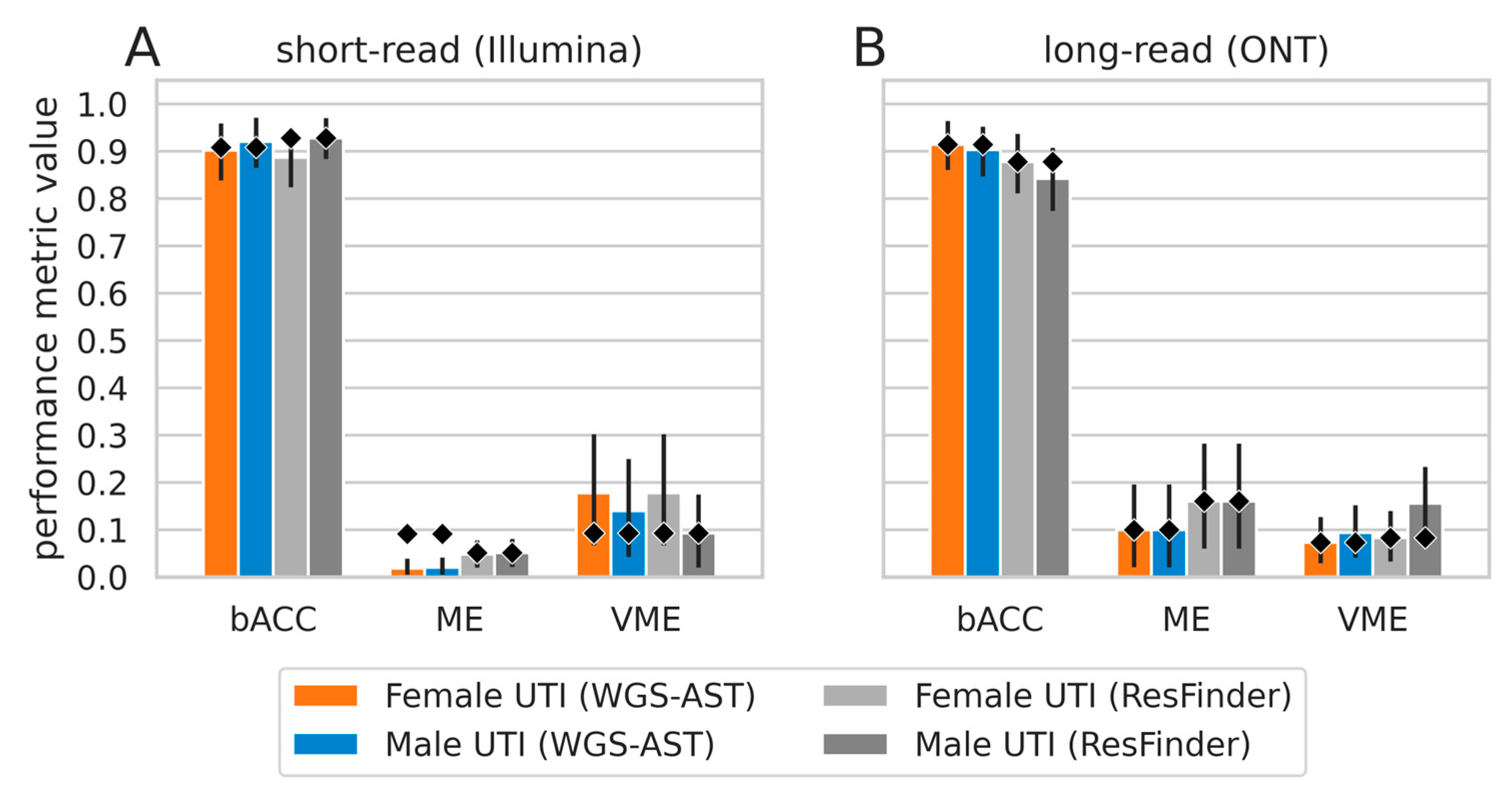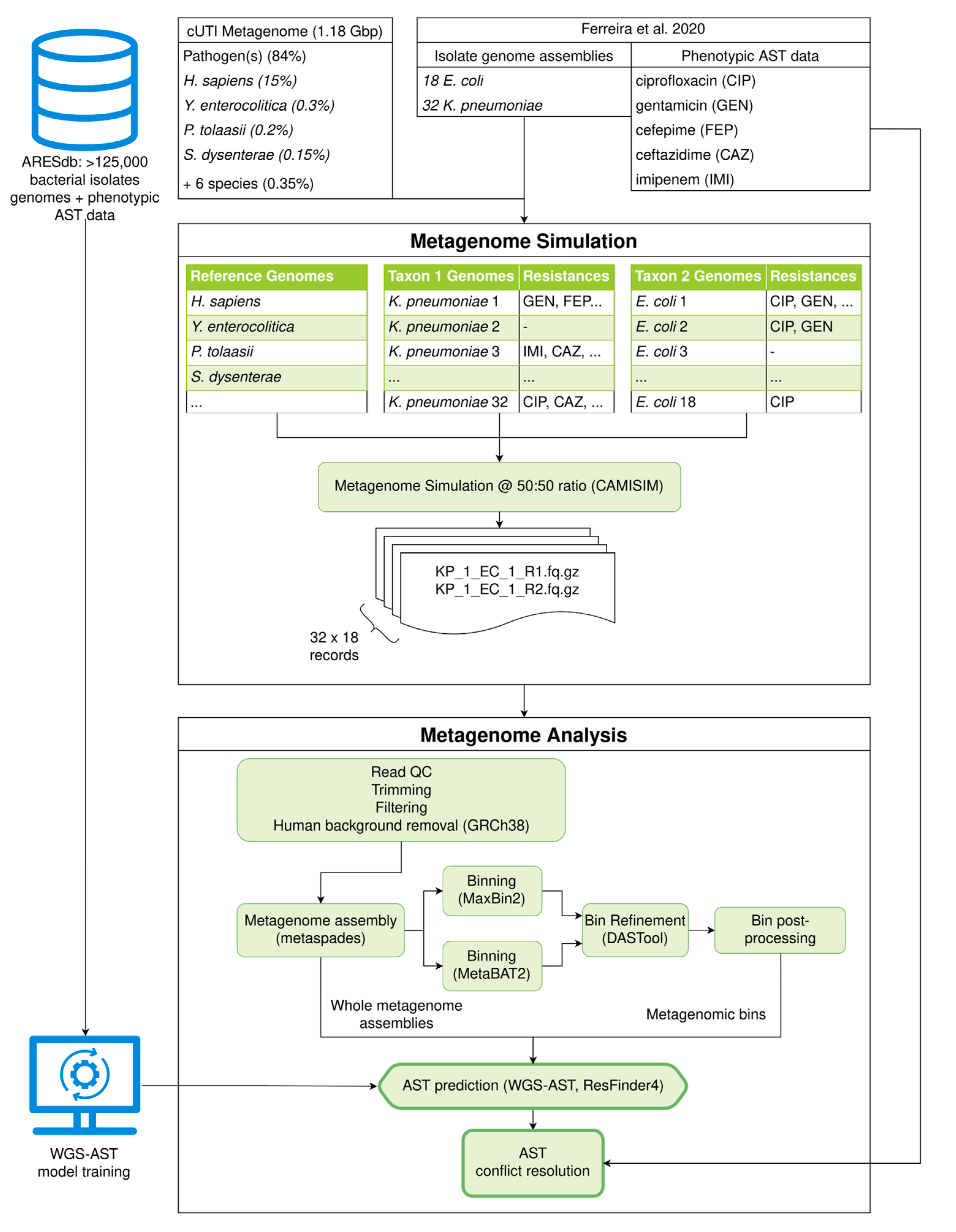Metagenomic Antimicrobial Susceptibility Testing from Simulated Native Patient Samples
Abstract
:1. Introduction
2. Results
2.1. Mono-Infection Scenarios
2.1.1. Impact of Sequencing Depth and Human Background Reads on MG-AST Accuracy
2.1.2. MG-AST Accuracy on Simulated E. coli cUTI Metagenomes
2.2. Co-Infection Scenarios
2.2.1. MG-AST for Co-Infections with Metagenomic Binning
2.2.2. Resolving Co-Infection Scenarios with Resistome Analysis
3. Discussion
4. Materials and Methods
4.1. Taxonomic Profiles, Genomic and Antimicrobial Susceptibility Data
4.2. Metagenome Simulation
4.3. WGS-AST Model Selection and Training
4.4. Pre-Processing and Assembly of Simulated Metagenomes
4.5. Metagenomic Binning and Taxon Assignment
4.6. MG-AST Analysis
5. Conclusions
Supplementary Materials
Author Contributions
Funding
Institutional Review Board Statement
Informed Consent Statement
Data Availability Statement
Acknowledgments
Conflicts of Interest
References
- O’Neill, J. Tackling Drug-Resistant Infections Globally. J. Pharm. Anal. 2016, 6, 71–79. [Google Scholar]
- Su, M.; Satola, S.W.; Read, T.D. Genome-Based Prediction of Bacterial Antibiotic Resistance. J. Clin. Microbiol. 2019, 57, e01405-18. [Google Scholar] [CrossRef] [PubMed]
- Bortolaia, V.; Kaas, R.S.; Ruppe, E.; Roberts, M.C.; Schwarz, S.; Cattoir, V.; Philippon, A.; Allesoe, R.L.; Rebelo, A.R.; Florensa, A.F.; et al. ResFinder 4.0 for Predictions of Phenotypes from Genotypes. J. Antimicrob. Chemother. 2020, 75, 3491–3500. [Google Scholar] [CrossRef] [PubMed]
- Bradley, P.; Gordon, N.C.; Walker, T.M.; Dunn, L.; Heys, S.; Huang, B.; Earle, S.; Pankhurst, L.J.; Anson, L.; de Cesare, M.; et al. Rapid Antibiotic-Resistance Predictions from Genome Sequence Data for Staphylococcus Aureus and Mycobacterium Tuberculosis. Nat. Commun. 2015, 6, 10063. [Google Scholar] [CrossRef] [PubMed]
- Lüftinger, L.; Májek, P.; Beisken, S.; Rattei, T.; Posch, A.E. Learning From Limited Data: Towards Best Practice Techniques for Antimicrobial Resistance Prediction From Whole Genome Sequencing Data. Front. Cell. Infect. Microbiol. 2021, 11, 610348. [Google Scholar] [CrossRef] [PubMed]
- Nguyen, M.; Brettin, T.; Long, S.W.; Musser, J.M.; Olsen, R.J.; Olson, R.; Shukla, M.; Stevens, R.L.; Xia, F.; Yoo, H.; et al. Developing an in Silico Minimum Inhibitory Concentration Panel Test for Klebsiella Pneumoniae. Sci. Rep. 2018, 8, 421. [Google Scholar] [CrossRef]
- Drouin, A.; Giguère, S.; Déraspe, M.; Marchand, M.; Tyers, M.; Loo, V.G.; Bourgault, A.-M.; Laviolette, F.; Corbeil, J. Predictive Computational Phenotyping and Biomarker Discovery Using Reference-Free Genome Comparisons. BMC Genom. 2016, 17, 754. [Google Scholar] [CrossRef]
- Davis, J.J.; Boisvert, S.; Brettin, T.; Kenyon, R.W.; Mao, C.; Olson, R.; Overbeek, R.; Santerre, J.; Shukla, M.; Wattam, A.R.; et al. Antimicrobial Resistance Prediction in PATRIC and RAST. Sci. Rep. 2016, 6, 1–12. [Google Scholar] [CrossRef]
- Drouin, A.; Letarte, G.; Raymond, F.; Marchand, M.; Corbeil, J.; Laviolette, F. Interpretable Genotype-to-Phenotype Classifiers with Performance Guarantees. Sci. Rep. 2019, 9, 4071. [Google Scholar] [CrossRef]
- Ferreira, I.; Beisken, S.; Lueftinger, L.; Weinmaier, T.; Klein, M.; Bacher, J.; Patel, R.; von Haeseler, A.; Posch, A.E. Species Identification and Antibiotic Resistance Prediction by Analysis of Whole-Genome Sequence Data by Use of ARESdb: An Analysis of Isolates from the Unyvero Lower Respiratory Tract Infection Trial. J. Clin. Microbiol. 2020, 58, e00273-20. [Google Scholar] [CrossRef]
- Yang, C.; Chowdhury, D.; Zhang, Z.; Cheung, W.K.; Lu, A.; Bian, Z.; Zhang, L. A Review of Computational Tools for Generating Metagenome-Assembled Genomes from Metagenomic Sequencing Data. Comput. Struct. Biotechnol. J. 2021, 19, 6301–6314. [Google Scholar] [CrossRef]
- Maguire, F.; Jia, B.; Gray, K.L.; Lau, W.Y.V.; Beiko, R.G.; L Brinkman, F.S. Metagenome-Assembled Genome Binning Methods with Short Reads Disproportionately Fail for Plasmids and Genomic Islands. Microb. Genom. 2020, 6, mgen000436. [Google Scholar] [CrossRef]
- Galata, V.; Laczny, C.C.; Backes, C.; Hemmrich-Stanisak, G.; Schmolke, S.; Franke, A.; Meese, E.; Herrmann, M.; von Müller, L.; Plum, A.; et al. Integrating Culture-Based Antibiotic Resistance Profiles with Whole-Genome Sequencing Data for 11,087 Clinical Isolates. Genom. Proteom. Bioinform. 2019, 17, 169–182. [Google Scholar] [CrossRef] [PubMed]
- Tande, A.J.; Patel, R. Prosthetic Joint Infection. Clin. Microbiol. Rev. 2014, 27, 302–345. [Google Scholar] [CrossRef]
- Wattam, A.R.; Davis, J.J.; Assaf, R.; Boisvert, S.; Brettin, T.; Bun, C.; Conrad, N.; Dietrich, E.M.; Disz, T.; Gabbard, J.L.; et al. Improvements to PATRIC, the All-Bacterial Bioinformatics Database and Analysis Resource Center. Nucleic Acids Res. 2016, 45, 535–542. [Google Scholar] [CrossRef]
- NCBI National Database of Antibiotic Resistant Organisms (NDARO)—Pathogen Detection—NCBI. Available online: https://www.ncbi.nlm.nih.gov/pathogens/antimicrobial-resistance/ (accessed on 11 November 2022).
- Májek, P.; Lüftinger, L.; Beisken, S.; Rattei, T.; Materna, A. Genome-Wide Mutation Scoring for Machine-Learning-Based Antimicrobial Resistance Prediction. Int. J. Mol. Sci. 2021, 22, 13049. [Google Scholar] [CrossRef]
- Lepuschitz, S.; Weinmaier, T.; Mrazek, K.; Beisken, S.; Weinberger, J.; Posch, A.E. Analytical Performance Validation of Next-Generation Sequencing Based Clinical Microbiology Assays Using a K-Mer Analysis Workflow. Front. Microbiol. 2020, 11, 1883. [Google Scholar] [CrossRef]
- Kang, D.D.; Li, F.; Kirton, E.; Thomas, A.; Egan, R.; An, H.; Wang, Z. MetaBAT 2: An Adaptive Binning Algorithm for Robust and Efficient Genome Reconstruction from Metagenome Assemblies. PeerJ 2019, 7, e7359. [Google Scholar] [CrossRef]
- Sieber, C.M.K.; Probst, A.J.; Sharrar, A.; Thomas, B.C.; Hess, M.; Tringe, S.G.; Banfield, J.F. Recovery of Genomes from Metagenomes via a Dereplication, Aggregation and Scoring Strategy. Nat. Microbiol. 2018, 3, 836–843. [Google Scholar] [CrossRef]
- NCBI SRA Metadata. Available online: s3://sra-pub-metadata-us-east-1/sra/metadata/ (accessed on 11 November 2022).
- Tabak, Y.P.; Vankeepuram, L.; Ye, G.; Jeffers, K.; Gupta, V.; Murray, P.R.; Carroll, K.C.; Hopkins, J. Blood Culture Turnaround Time in U.S. Acute Care Hospitals and Implications for Laboratory Process Optimization. J. Clin. Microbiol. 2018, 56, 500–518. [Google Scholar] [CrossRef]
- Břinda, K.; Callendrello, A.; Ma, K.C.; MacFadden, D.R.; Charalampous, T.; Lee, R.S.; Cowley, L.; Wadsworth, C.B.; Grad, Y.H.; Kucherov, G.; et al. Rapid Inference of Antibiotic Resistance and Susceptibility by Genomic Neighbour Typing. Nat. Microbiol. 2020, 5, 455–464. [Google Scholar] [CrossRef]
- Lüftinger, L.; Ferreira, I.; Frank, B.J.H.; Beisken, S.; Weinberger, J.; von Haeseler, A.; Rattei, T.; Hofstaetter, J.G.; Posch, A.E.; Materna, A. Predictive Antibiotic Susceptibility Testing by Next-Generation Sequencing for Periprosthetic Joint Infections: Potential and Limitations. Biomedicines 2021, 9, 910. [Google Scholar] [CrossRef]
- Sundermann, A.J.; Chen, J.; Kumar, P.; Ayres, A.M.; Cho, S.T.; Ezeonwuka, C.; Griffith, M.P.; Miller, J.K.; Mustapha, M.M.; Pasculle, A.W.; et al. Whole-Genome Sequencing Surveillance and Machine Learning of the Electronic Health Record for Enhanced Healthcare Outbreak Detection. Clin. Infect. Dis. 2022, 75, 476–482. [Google Scholar] [CrossRef]
- Gordon, L.G.; Elliott, T.M.; Forde, B.; Mitchell, B.; Russo, P.L.; Paterson, D.L.; Harris, P.N.A. Budget Impact Analysis of Routinely Using Whole-Genomic Sequencing of Six Multidrug-Resistant Bacterial Pathogens in Queensland, Australia. BMJ Open 2021, 11, e041968. [Google Scholar] [CrossRef]
- Ferreira, I.; Lepuschitz, S.; Beisken, S.; Fiume, G.; Mrazek, K.; Frank, B.J.H.; Huber, S.; Knoll, M.A.; von Haeseler, A.; Materna, A.; et al. Culture-Free Detection of Antibiotic Resistance Markers from Native Patient Samples by Hybridization Capture Sequencing. Microorganisms 2021, 9, 1672. [Google Scholar] [CrossRef]
- Wood, D.E.; Lu, J.; Langmead, B. Improved Metagenomic Analysis with Kraken 2. Genome Biol. 2019, 20, 257. [Google Scholar] [CrossRef]
- Fritz, A.; Hofmann, P.; Majda, S.; Dahms, E.; Dröge, J.; Fiedler, J.; Lesker, T.R.; Belmann, P.; Demaere, M.Z.; Darling, A.E.; et al. CAMISIM: Simulating Metagenomes and Microbial Communities. Microbiome 2019, 7, 17. [Google Scholar] [CrossRef]
- Huang, W.; Li, L.; Myers, J.R.; Marth, G.T. ART: A next-Generation Sequencing Read Simulator. Bioinformatics 2012, 28, 593–594. [Google Scholar] [CrossRef]
- Ono, Y.; Asai, K.; Hamada, M. PBSIM: PacBio Reads Simulator—Toward Accurate Genome Assembly. Bioinformatics 2013, 29, 119–121. [Google Scholar] [CrossRef]
- Nicholls, S.M.; Quick, J.C.; Tang, S.; Loman, N.J. Ultra-Deep, Long-Read Nanopore Sequencing of Mock Microbial Community Standards. Gigascience 2019, 8, giz043. [Google Scholar] [CrossRef]
- Chen, T.; Guestrin, C. XGBoost: A Scalable Tree Boosting System. In Proceedings of the 22nd ACM SIGKDD International Conference on Knowledge Discovery and Data Mining; ACM: New York, NY, USA, 2016; pp. 785–794. [Google Scholar]
- Langmead, B.; Salzberg, S.L. Fast Gapped-Read Alignment with Bowtie 2. Nat. Methods 2012, 9, 357–359. [Google Scholar] [CrossRef]
- Bolger, A.M.; Lohse, M.; Usadel, B. Trimmomatic: A Flexible Trimmer for Illumina Sequence Data. Bioinformatics 2014, 30, 2114. [Google Scholar] [CrossRef]
- Bankevich, A.; Nurk, S.; Antipov, D.; Gurevich, A.A.; Dvorkin, M.; Kulikov, A.S.; Lesin, V.M.; Nikolenko, S.I.; Pham, S.; Prjibelski, A.D.; et al. SPAdes: A New Genome Assembly Algorithm and Its Applications to Single-Cell Sequencing. J. Comput. Biol. 2012, 19, 455–477. [Google Scholar] [CrossRef]
- Li, H. Minimap2: Pairwise Alignment for Nucleotide Sequences. Bioinformatics 2018, 34, 3094–3100. [Google Scholar] [CrossRef]
- de Coster, W.; D’Hert, S.; Schultz, D.T.; Cruts, M.; van Broeckhoven, C. NanoPack: Visualizing and Processing Long-Read Sequencing Data. Bioinformatics 2018, 34, 2666–2669. [Google Scholar] [CrossRef]
- Kolmogorov, M.; Yuan, J.; Lin, Y.; Pevzner, P.A. Assembly of Long, Error-Prone Reads Using Repeat Graphs. Nat. Biotechnol. 2019, 37, 540–546. [Google Scholar] [CrossRef]
- Yang, C.; Chu, J.; Warren, R.L.; Birol, I. NanoSim: Nanopore Sequence Read Simulator Based on Statistical Characterization. Gigascience 2017, 6, gix010. [Google Scholar] [CrossRef]
- Krakau, S.; Straub, D.; Gourlé, H.; Gabernet, G.; Nahnsen, S. Nf-Core/Mag: A Best-Practice Pipeline for Metagenome Hybrid Assembly and Binning. NAR Genom. Bioinform. 2022, 4, lqac007. [Google Scholar] [CrossRef]
- Wu, Y.W.; Simmons, B.A.; Singer, S.W. MaxBin 2.0: An Automated Binning Algorithm to Recover Genomes from Multiple Metagenomic Datasets. Bioinformatics 2016, 32, 605–607. [Google Scholar] [CrossRef]
- Robertson, J.; Nash, J.H.E. MOB-Suite: Software Tools for Clustering, Reconstruction and Typing of Plasmids from Draft Assemblies. Microb. Genom. 2018, 4, e000206. [Google Scholar] [CrossRef]
- Conzemius, R.; Bergman, Y.; Májek, P.; Beisken, S.; Lewis, S.; Jacobs, E.B.; Tamma, P.D.; Simner, P.J. Automated Antimicrobial Susceptibility Testing and Antimicrobial Resistance Genotyping Using Illumina and Ox-ford Nanopore Technologies Sequencing Data among Enterobacteriaceae. Front. Microbiol. 2022, 13, 2851. [Google Scholar] [CrossRef]




| Method | Data Type | bACC | ME | VME |
|---|---|---|---|---|
| WGS-AST (AREScloud) | isolate assembly | 0.956 (0.941–0.969) | 0.046 (0.032–0.061) | 0.042 (0.021–0.071) |
| WGS-AST (ARESdb) | metagenomic bins | 0.915 (0.912–0.919) | 0.057 (0.054–0.061) | 0.112 (0.106–0.119) |
| WGS-AST (ARESdb) | resistome (max) | 0.923 (0.917–0.928) | 0.136 (0.126–0.147) | 0.019 (0.016–0.022) |
| WGS-AST (ARESdb) | resistome (most certain) | 0.926 (0.922–0.931) | 0.023 (0.019–0.029) | 0.124 (0.116–0.131) |
| ResFinder 4 | isolate assembly | 0.811 (0.781–0.837) | 0.184 (0.156–0.213) | 0.195 (0.149–0.246) |
| ResFinder 4 | metagenomic bin | 0.711 (0.706–0.717) | 0.274 (0.267–0.28) | 0.303 (0.294–0.312) |
| ResFinder 4 | resistome (max) | 0.812 (0.804–0.819) | 0.284 (0.269–0.298) | 0.093 (0.086–0.1) |
Disclaimer/Publisher’s Note: The statements, opinions and data contained in all publications are solely those of the individual author(s) and contributor(s) and not of MDPI and/or the editor(s). MDPI and/or the editor(s) disclaim responsibility for any injury to people or property resulting from any ideas, methods, instructions or products referred to in the content. |
© 2023 by the authors. Licensee MDPI, Basel, Switzerland. This article is an open access article distributed under the terms and conditions of the Creative Commons Attribution (CC BY) license (https://creativecommons.org/licenses/by/4.0/).
Share and Cite
Lüftinger, L.; Májek, P.; Rattei, T.; Beisken, S. Metagenomic Antimicrobial Susceptibility Testing from Simulated Native Patient Samples. Antibiotics 2023, 12, 366. https://doi.org/10.3390/antibiotics12020366
Lüftinger L, Májek P, Rattei T, Beisken S. Metagenomic Antimicrobial Susceptibility Testing from Simulated Native Patient Samples. Antibiotics. 2023; 12(2):366. https://doi.org/10.3390/antibiotics12020366
Chicago/Turabian StyleLüftinger, Lukas, Peter Májek, Thomas Rattei, and Stephan Beisken. 2023. "Metagenomic Antimicrobial Susceptibility Testing from Simulated Native Patient Samples" Antibiotics 12, no. 2: 366. https://doi.org/10.3390/antibiotics12020366
APA StyleLüftinger, L., Májek, P., Rattei, T., & Beisken, S. (2023). Metagenomic Antimicrobial Susceptibility Testing from Simulated Native Patient Samples. Antibiotics, 12(2), 366. https://doi.org/10.3390/antibiotics12020366






